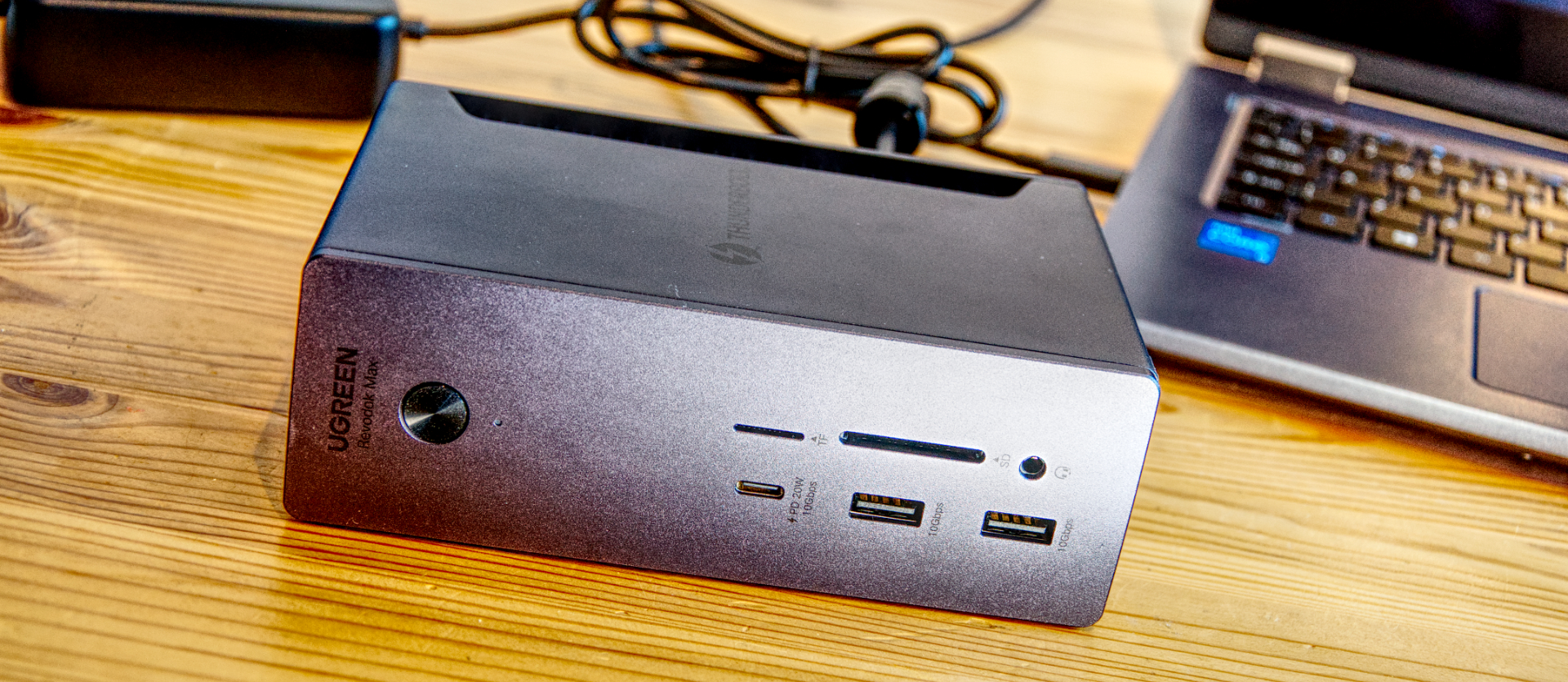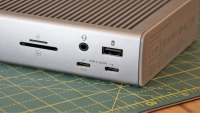TechRadar Verdict
Amazing build quality, a well-considered port selection, and a dual-form factor design make the Revodok Max 213 an absolute winner. The only issues here are that it is exclusively Thunderbolt, and there are much cheaper options for those who are fine with plastic peripherals.
Pros
- +
Built like a tank
- +
Thunderbolt 4 and USB 4.0
- +
Good port selection
- +
90W charging
Cons
- -
Only 2-year warranty
- -
Not USB 3.2 compatible
- -
No HDMI output
Why you can trust TechRadar
Ugreen Revodok Max 213: 30-second review
Ugreen has a second-to-none reputation for USB peripherals and cables, so the company's venture into Docks isn't a huge surprise.
The Revodok series has four current models, two each of the Pro and Max variants, with the Max 213 being the best and most expensive option.
That said, the Revodok Max 213 isn't the most costly Thunderbolt dock you can purchase, and its price has come down significantly since it was first launched earlier this year.
Typical pricing is £265 in the UK and $300 in the USA, directly from Ugreen, placing it as much cheaper than the Caldigit TS4 (£380/$380) but more expensive than the Plugable Thunderbolt 4 Dock ($200).
What you get for this outlay is a beautifully made dock that can be used horizontally or vertically, connects to a system using Thunderbolt 4 or 3, and provides extra USB ports, 2.5GbE LAN, Audio jack, SD and Micro SD card slots, DisplayPort monitor connectivity and three Thunderbolt downlinks.
There are docks with more ports, but they share the same 40Gbps of bandwidth between them as the Revodok Max 213.
The only technical weaknesses here are the lack of an HDMI port and the fact that this won't work with USB 3.2 Type-C. Ugreen has other docks, like the Revodok Pro 313, that are for USB-C use.
But, if you have Thunderbolt ports, the Max 213 is the perfect dock to exploit that and provides a single cable connection to a world of technology.
Ugreen Revodok Max 213: Price and availability

- How much does it cost? $300/£265
- When is it out? It is starting to be available now
- Where can you get it? Direct from Ugreen or through online retailers like Amazon.
The launch MSRP of the Max 213 was an eye-watering £359.99 or $346.99, but thankfully, Ugreen has ditched that price and is asking for £265 in the UK, $300 in the USA and €279.99 across Europe.
It can be found a little cheaper on some online sources, but typically within $5 of the cost directly from Ugreen.
That makes this dock more expensive than the cheaper options, with some docks from OWC and Plugable being around $200, but it is cheaper than the brand leaders Caldigit.
What might make this dock worth the extra over an entry-level Thunderbolt dock is its completely metal construction, which makes it more durable.
While this might seem like an expensive choice, there is a good argument that the engineering justifies this asking price.
- Value: 4 / 5
Ugreen Revodok Max 213: Specs
| Compatibility | TB4, TB3, USB 4.0 |
| Number of Ports | 13 |
| Ports | 1x TB4 upstream, 2x TB4 downstream, 1x USB 3.1 Gen 2 Type-C with 20W PD, 2x USB 3.2 Gen 1 Type-A, 2x USB 3.2 Gen 2 Type-A, 1x DisplayPort 1.4, 1x audio in/out jack,1x 2.5GbE RJ45 Ethernet port,1x UHS-II SD Card reader (320MBps), 1x UHS-II MicroSD Card reader (320MBps) |
| Downstream power | 15W Thunderbolt |
| Upstream power | 90W Thunderbolt |
| Size | 148.5 x 96.2 x 52mm (W x D x H) |
| Weight | ?1965g |
| Accessories | Adapter 180W 21V 8.57A |
Ugreen Revodok Max 213: Design
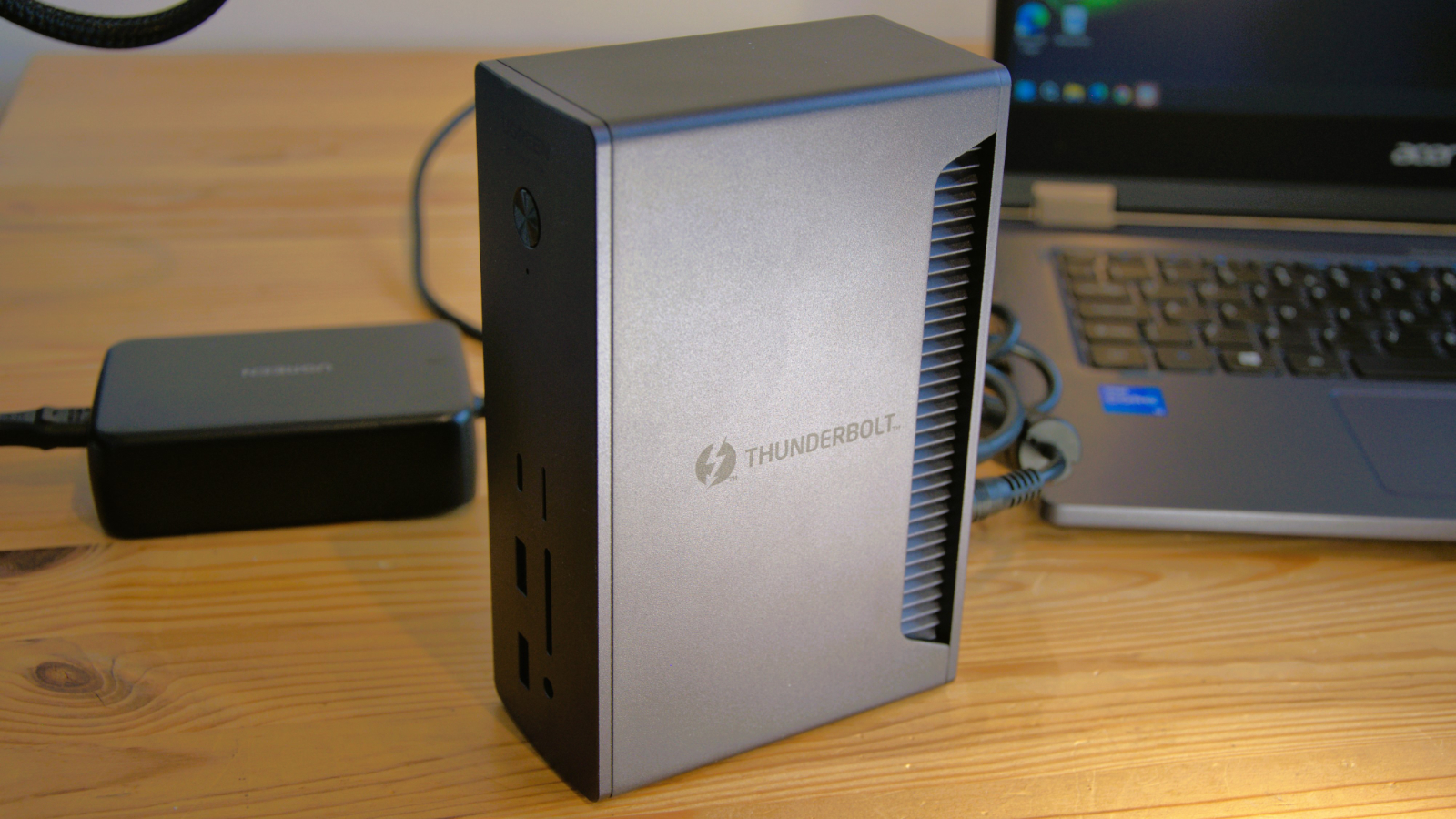
- Vertical or horizontal
- Built like a battleship
- No HDMI port or security slot
We've seen one other dock with a similar shape and size, the excellent and expensive Caldigit TS4. The Max 213 is a bit longer and wider, but like the TS4, it can be orientated vertically or horizontally, depending on personal preferences.
The Caldigit TS4 is a nicely made dock that's primarily metal, but the Ugreen Revodok Max 213 construction is on an entirely different level.
The aluminium thickness is at least 4mm all around, and this dock is nearly 2kg without the power supply. With rubber feet on the bottom and side, this dock won't easily be sliding at all on even the most polished desk.
Front-facing ports include three USB ports, two Type-A and one Type-C, all with 10Gbps performance, two SD card readers for full SD and Micro SD, and a 3.5mm audio jack.
Ugreen also put a power button on this dock, something Caldigit left out of the TS4, regrettably.
One neat divergence from what most dock makers offer is that the USB-C on the front can deliver up to 20W, making it ideal for charging most phones.
On the back are more USB (only 5Gbps Type-A), a single 2.5GbE LAN port, a DisplayPort out and three Thunderbolt 4 ports, one of these being the uplink.
Some will complain that the DisplayPort should have been an HDMI, but if you must have HDMI, a Thunderbolt to HDMI cable is relatively inexpensive.
Those who don't read the high-quality documentation that Ugreen includes might try to connect a laptop to the front-facing USB-C and wonder why it doesn't work, but it should eventually work out that it should be connected at the rear.
The only omission that we'd recommend Ugreen add is a security slot. This dock is so elegantly engineered that someone might relocate it if it isn't secured.
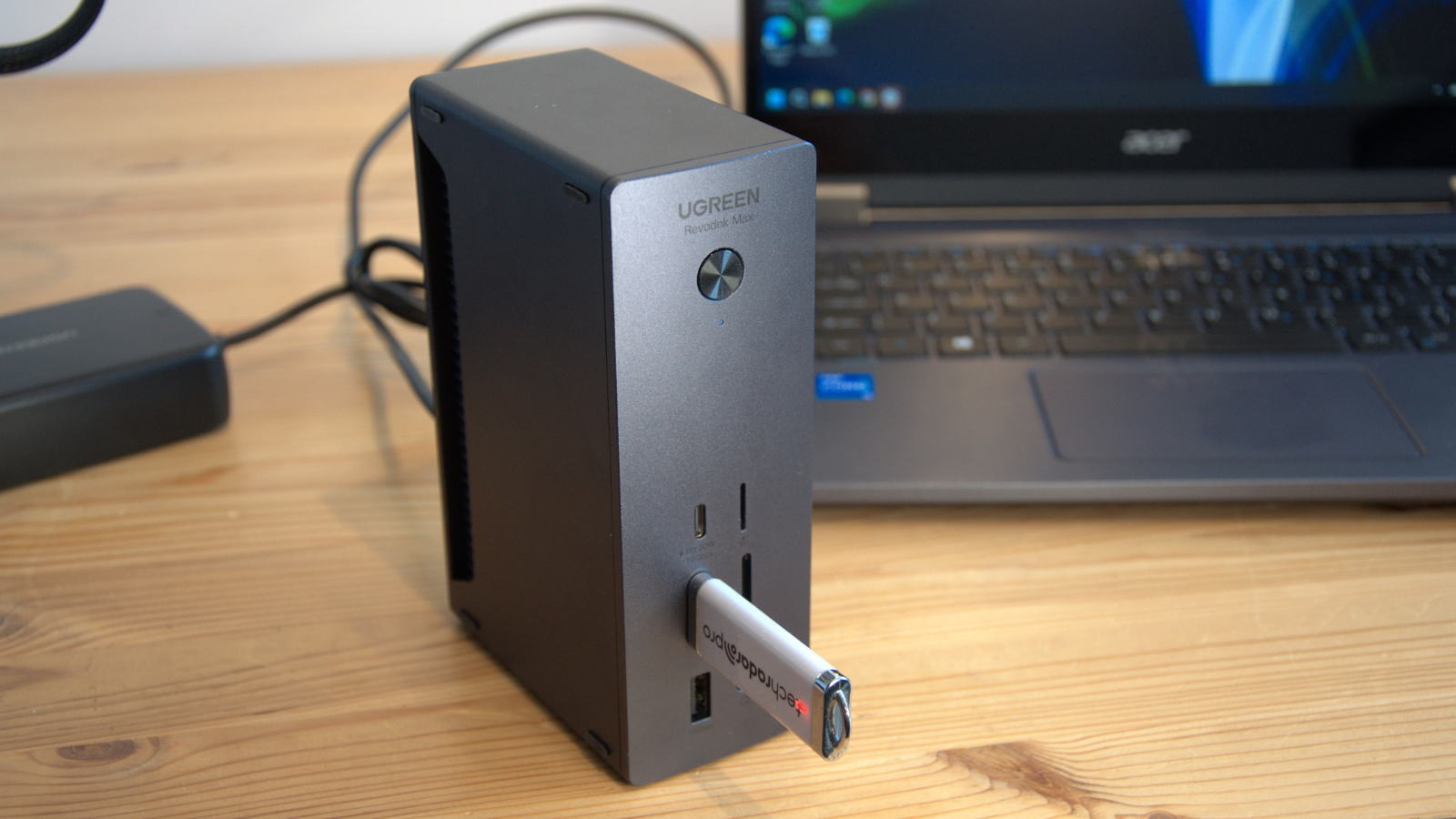
- Design: 4 / 5
Ugreen Revodok Max 213: Features
- Bandwidth oversubscribed
- Only 8K displays on Windows
- Charging port
Ugreen hasn't revealed the specifications of the internal technology used in the Max 213, but it has all the hallmarks of the Intel JHL8440, like most modern Thunderbolt designs.
In common with those alternatives, the 40Gbps of available Thunderbolt 4 bandwidth is oversubscribed with the provided port selection.
When you consider that USB ports alone represent 45Gbps, and that doesn't include the LAN port, SD card readers or the Thunderbolt downlinks (each up to 20Gbps), then it isn't practical to run data at full speed through all of them at once.
That said, the selection of ports here covers the requirements of most customers, and it is unlikely that someone would try to use all of them actively.
The snags come when users want to file transfer between two Thunderbolt SSDs and use the monitor functionality because something must concede for this to happen.
None of this is new to Thunderbolt or USB docks, but it is good to outline that having thirteen ports doesn't necessarily enable them to be used simultaneously.
Using this dock to connect monitors comes with a few caveats best revealed, especially for Apple Macbook owners.
Under Windows, Thunderbolt or DisplayPort monitors support up to 8K resolution at 30Hz or dual display at 4K at 60Hz. Sadly, on the Apple MacBook (M1, M2, or M3), the maximum resolution is 4K at 6Hz in single or dual display configuration.
This might not be a huge issue, given how few people have an 8K display, but it's a documented limitation.
For those curious, this device doesn't have a single USB-C port, so it can't drive yet another screen. But although undocumented, it will drive a 5K panel using DisplayPort.
A definite strength of this design is the power distribution, with the headline Thunderbolt power output of 90W on the uplink connection. That's more than enough for most laptops, and those that require more than that much power typically don't use a USB-C connection to charge.
Each of the downlink Thunderbolt ports can deliver 15W, and the USB-A ports 7.5W. The one USB-C port Ugreen included is explicitly designed for phone fast charging and can deliver 20W for that purpose.
Adding all those potential demands up makes for 162.5W, a good chunk of the 180W the PSU delivers, and those numbers don't include the overheads of the dock, LAN port and other items. However, it's unlikely that any of the power-demanding connections would be at maximum ratings, and logically, the dock can reduce output on the uplink to avoid impacting peripherals.
For those wanting even more power, the Caldigit TS4 has a 230W PSU and more USB ports, but it also has an enormous power supply three times larger than the one Ugreen supplies with the Max 213.

For those curious, this device doesn't have a single USB-C port, so it can't drive yet another screen. But although undocumented, it will drive a 5K panel using DisplayPort.
A definite strength of this design is the power distribution, with the headline Thunderbolt power output of 90W on the uplink connection. That's more than enough for most laptops, and those that require more than that much power typically don't use a USB-C connection to charge.
Each of the downlink Thunderbolt ports can deliver 15W, and the USB-A ports 7.5W. The one USB-C port Ugreen included is explicitly designed for phone fast charging and can deliver 20W for that purpose.
Adding all those potential demands up makes for 162.5W, a good chunk of the 180W the PSU delivers, and those numbers don't include the overheads of the dock, LAN port and other items. However, it's unlikely that any of the power-demanding connections would be at maximum ratings, and logically, the dock can reduce output on the uplink to avoid impacting peripherals.
For those wanting even more power, the Caldigit TS4 has a 230W PSU and more USB ports, but it also has an enormous power supply three times larger than the one Ugreen supplies with the Max 213.
- Features: 4 / 5
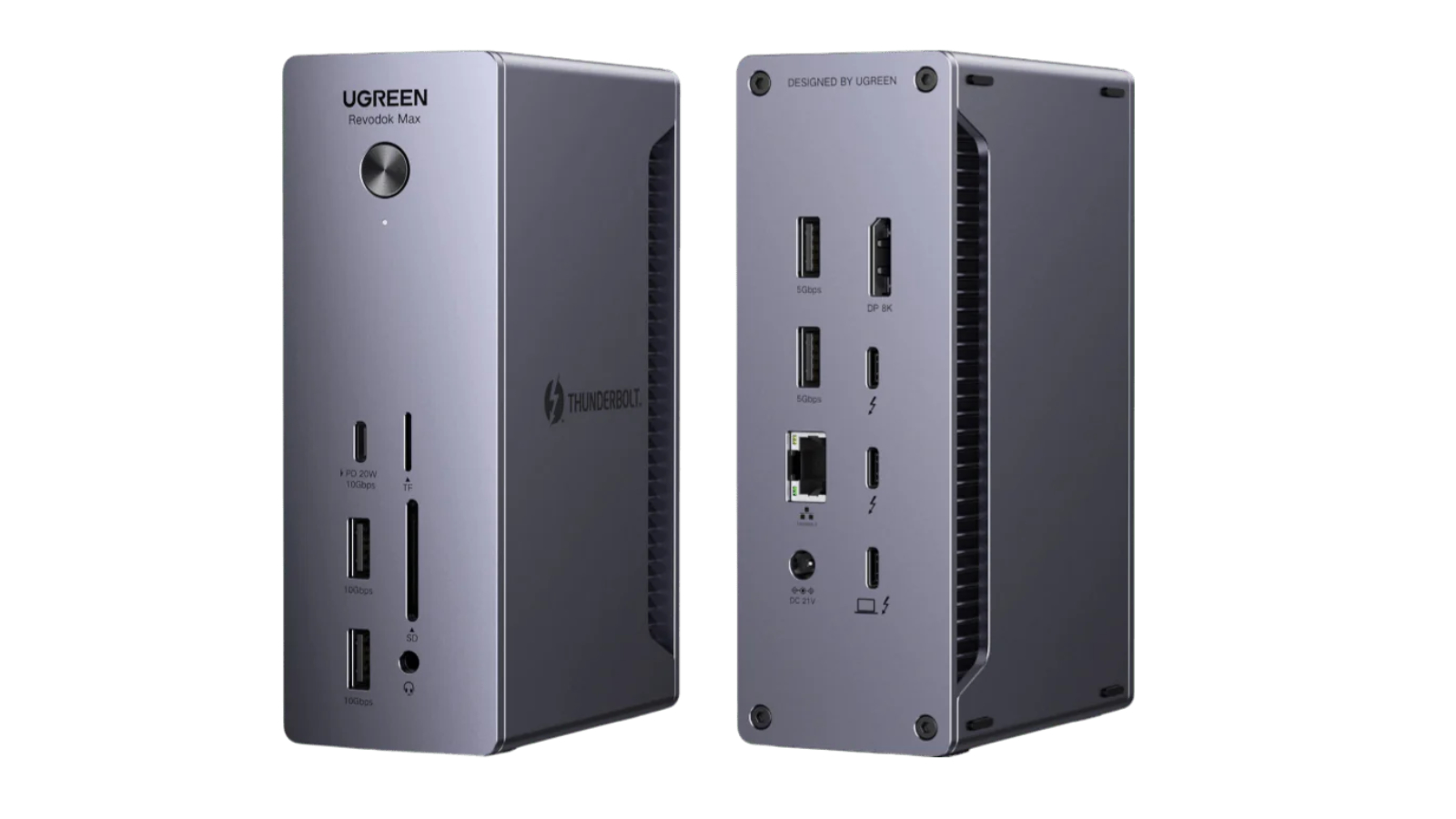
Ugreen Revodok Max 213: Performance
- Ballpark performance
- Reliable connectivity
With most Thunderbolt docks using the same silicon for the backbone of these devices, the differences between the Max 213 and other brands are minimal.
We generally test their performance using the OWC Envoy FX SSD, an extremely high-performance storage device for which we have a baseline number for direct attachment.
The Max 213's performance is closely aligned to that of the Plugable Thunderbolt 4 (TBT4-UDX1), with the fastest transfers being 2936MB/s read and 1514MB/s write. That's slightly faster reading and writing than the Plugable, but not the quickest dock we've tested.
Comparing these numbers to the baseline of directly connecting the OWC Envoy FX SSD to the host system reveals that read performance is almost identical, but write performance is 25% below a direct connection.
All our tests were performed with write caching enabled for maximum speed, and these fall within the expected speeds for other Thunderbolt 4 docks.
While not practically quantifiable, it was noted that the connectivity of this dock when connecting to the host system and the speed of identifying inserted peripherals was excellent. And, we didn't see anything being ignored, like we have on some docks.
Ugreen Revodok Max 213: Verdict
Ugreen has made a remarkably robust and functional dock that ticks most of the feature requirements at a price that isn't crazy.
However, given how sturdy this device is from the outside, it should give many more years of service than the two years the Ugreen warranty lasts.
From a functionality standpoint, the only significant omission is that it only offers DisplayPort or Thunderbolt monitor connections, even if conversion cables for Thunderbolt are relatively cheap.
But the biggest problem for corporate customers buying this hardware is that without a security slot, it's debatable how long such an attractive piece of hardware will remain on the desk it was deployed.
Ugreen Revodok Max 213: Report card
| Value | Not cheap, but value for money | 4 / 5 |
| Design | Simple layout with two orientations and tank-like construction. | 4 / 5 |
| Features | Good port selection, even if it has no HDMI out. | 4 / 5 |
| Performance | Lots of monitors for PC owners, fewer for Mac users | 4 / 5 |
| Overall | The price is more realistic now, making this a good all-rounder | 4 / 5 |
Should you buy a Ugreen Revodok Max 213?
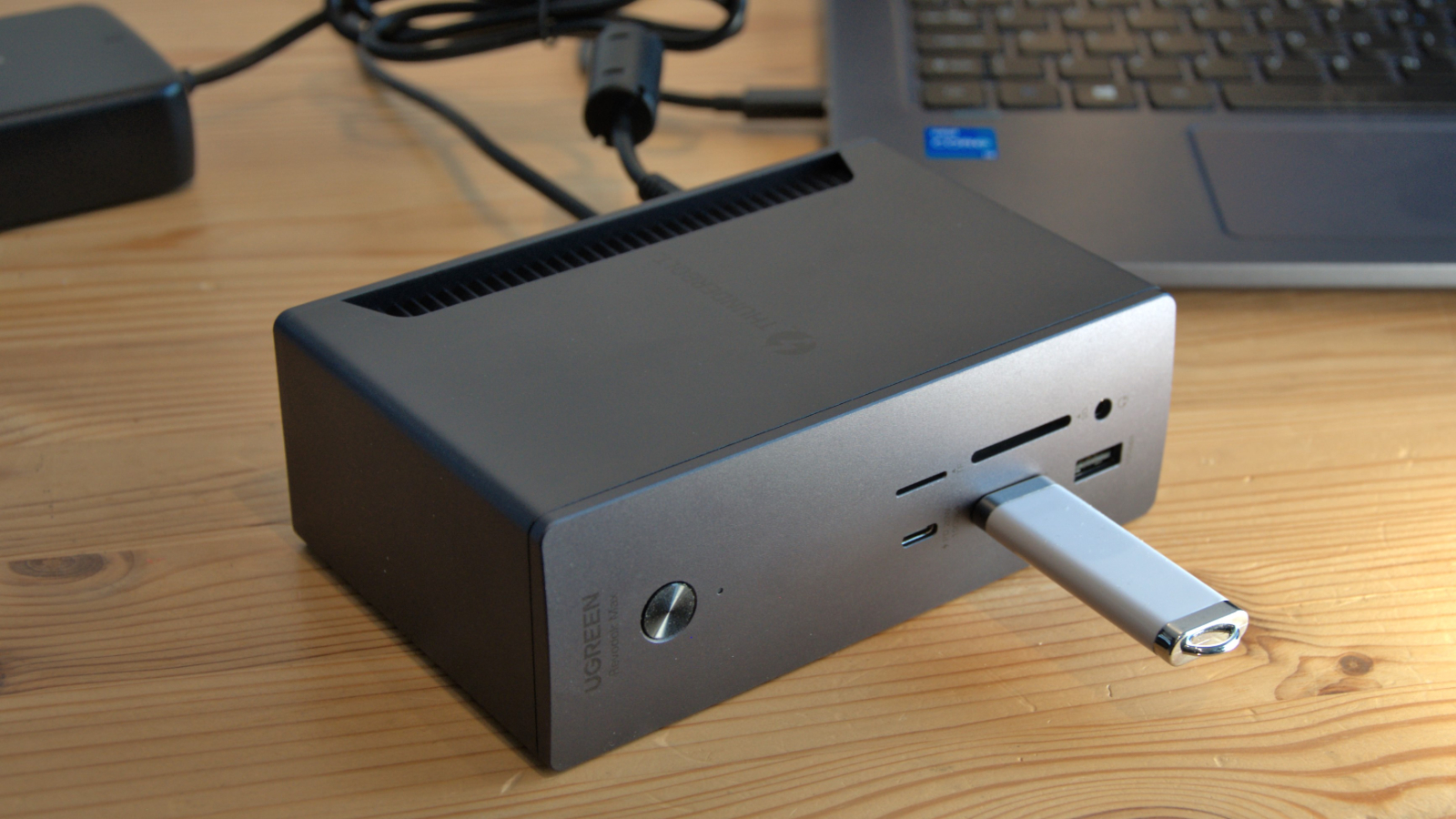
Buy it if...
You want a dock that is visible
The small form factor of the Max 213 makes it ideal to place on the desk, since it takes up little space and looks attractive. The metal construction also makes it heavy, so it won't easily get knocked off.
You like Ugreen products
The reputation that Ugreen has cultivated is one where quality is of paramount importance, and this dock supports those objectives in spades. The only fly in that ointment is that Ugreen only offers a 2-year warranty, confusingly.
Don't buy it if...
You don't have Thunderbolt or USB 4.0
Making use of the functionality in this dock requires either Thunderbolt 3/4 or USB 4.0 ports, USB 3.2 Type-C is not going to work in this context.
You are working to a budget
Thunderbolt docks are available for closer to $200, offering some of this design's features. These are often less well-made, but they offer similar connectivity. There are cheaper docks if you aren't worried about how long they might last in use.
Also consider
OWC Thunderbolt Dock
A much cheaper but still high-quality dock from OWC, this design has eleven ports and offers 90W charging for a Thunderbolt-connected laptop. What it lacks is a dedicated monitor port, but adapters for HDMI or Display port from Thunderbolt are available.
Check out our OWC Thunderbolt Dock review
CalDigit Thunderbolt Station 4
The CalDigit Thunderbolt Station 4, or TS4 as it is also known, is a full-featured Thunderbolt dock that works with Thunderbolt 4/3 and USB-C.
It is not designed to be a portable dock but specifically to support a laptop user who comes to the office and wants a single cable connection to the network and a host of peripherals. To that objective, it has no less than 18 ports and can deliver up to 98W for charging a connected system. But, it is expensive.
Check out our CalDigit Thunderbolt Station 4 (TS4) review
Mark is an expert on 3D printers, drones and phones. He also covers storage, including SSDs, NAS drives and portable hard drives. He started writing in 1986 and has contributed to MicroMart, PC Format, 3D World, among others.
